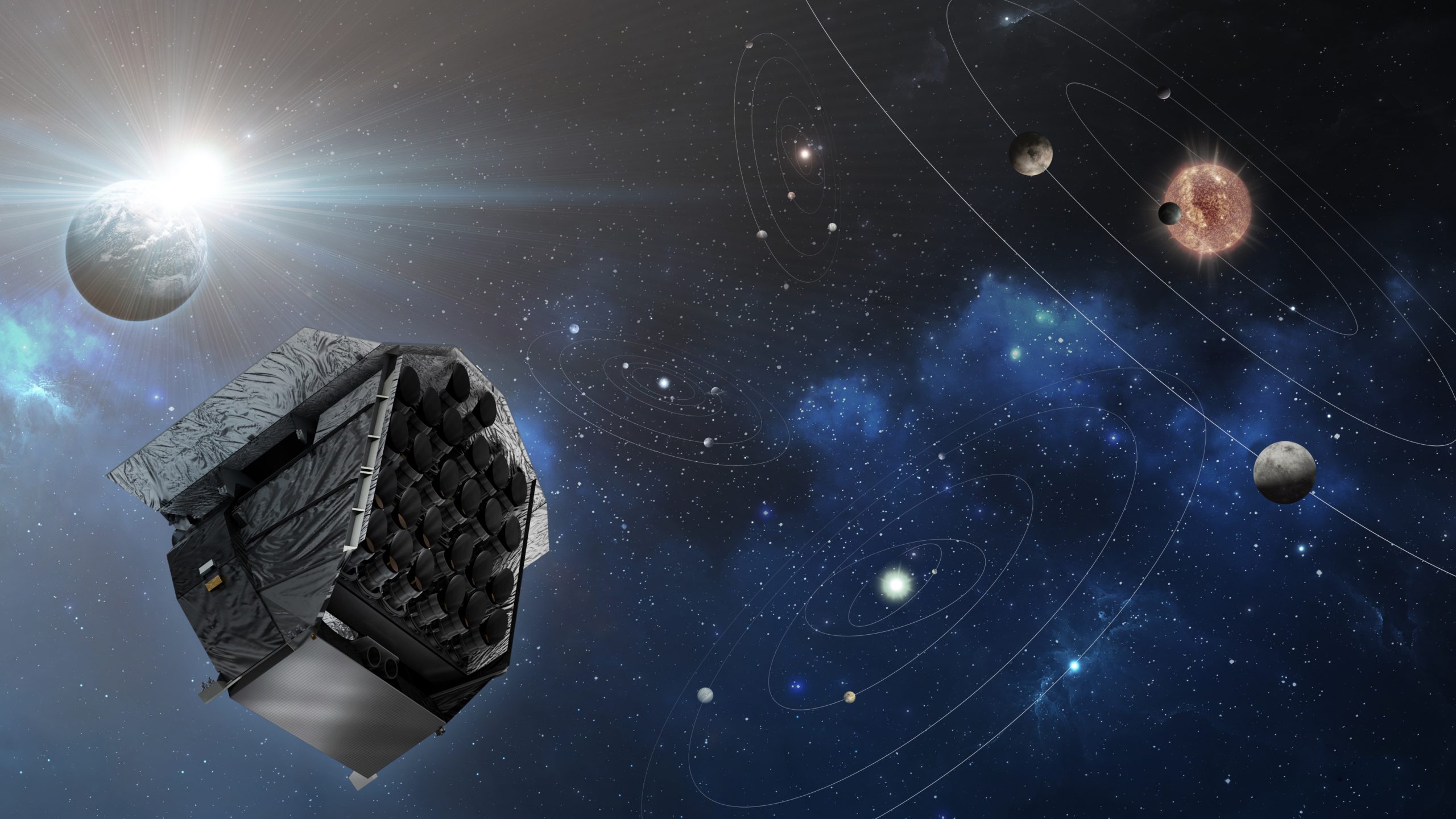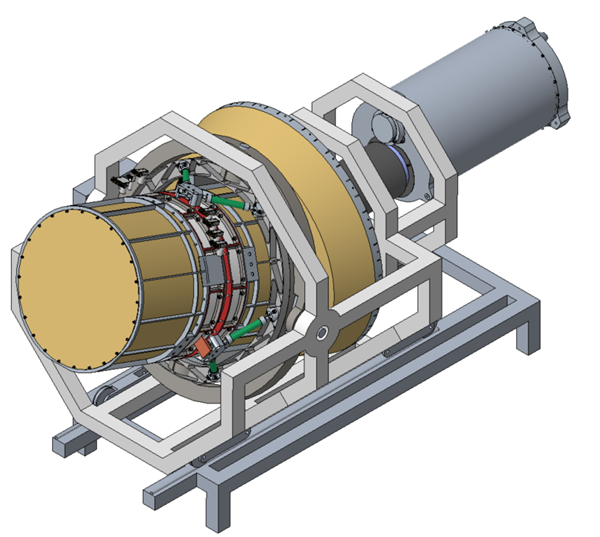(English follows Dutch)
SRON ontwerpt en bouwt een ruimtesimulator om acht van de zesentwintig camera’s te testen en kalibreren voor ESA’s nieuwe exoplaneetjager PLATO. Het conceptontwerp is nu klaar. PLATO zal in staat zijn om kleinere planeten in grotere banen te spotten dan haar voorgangers. Dit kan leiden tot de ontdekking van aardachtige planeten binnen de leefbare zone rond een ster. De ruimtetelescoop is zelfs gevoelig genoeg om de eigenschappen te meten van mogelijke atmosferen rond deze planeten.

Tijdens het afgelopen decennium hebben astronomen een vloedgolf aan exoplaneten ontdekt. Ze zijn inmiddels tot de conclusie gekomen dat er op zijn minst evenveel planeten in het heelal bestaan als sterren. Alleen al door onze Melkweg moeten er meer dan honderd miljard planeten rondzweven. Op dit moment zijn er ruim vierduizend planeten bevestigd.
Onafgebroken monitoring
De effectiefste manier om planeten te ontdekken is zoeken naar minieme variaties in de helderheid van een ster. Een planeet verraadt zijn aanwezigheid als hij voor de ster langs vliegt en daarbij een beetje sterlicht blokkeert. ESA’s PLATO-telescoop gaat diezelfde methode gebruiken, met als speciaal trucje dat ze individuele sterren jarenlang onafgebroken blijft aanstaren. Daarmee kunnen sterrenkundigen kleinere planeten ontdekken met overgangen die langer duren, ten opzichte van eerdere exoplaneetjagers. Hier betreden we het domein van de aardachtige planeten binnen de leefbare zone rond een moederster. Daarbovenop stelt PLATO’s gevoeligheid wetenschappers in staat om eigenschappen te achterhalen van mogelijke atmosferen rond deze planeten, zoals wolkendekken, en om een catalogus op te bouwen voor vervolgonderzoek naar buitenaardse atmosferen.
Simulator
SRON ontwerpt en bouwt een ruimtesimulator om acht van PLATO’s zesentwintig camera’s te testen en kalibreren. SRON-wetenschappers hebben nu hun conceptontwerp af. Ze gaan de simulator gebruiken om de omvang en vorm te bepalen van de zogenoemde point-spread functie. In plaats van een puntbron zien telescopen een ster in de vorm van een schijf die het felste is in het centrum en scherp afzwakt richting de rand. Dat komt door piepkleine imperfecties in de optica van de telescoop. In SRON’s ontwerp simuleren optica een ster aan de hemel terwijl een stralingsschild de extreem lage temperaturen van de ruimte nabootst. Dat laatste is onderdeel van een andere, net zo belangrijke test om de correcte werking te verifiëren van de camera in de ruimte. Uiteindelijk bepaalt de simulator of de camera’s voldoen aan de vereisten voor PLATO en levert hij belangrijke kalibratieparameters.

Schoon
Omdat de echte vluchtcamera’s worden getest, is de simulator op zo’n manier ontworpen dat hij maximale bescherming biedt. Een enkel stofdeeltje kan al leiden tot verminderde gevoeligheid en valse detecties. ‘PLATO heeft strenge richtlijnen rondom besmetting, zelfs vergeleken met andere ruimtetelescopen, dus we moeten de camera’s testen in extreem schone omstandigheden,’ zegt Lorenza Ferrari, SRON’s projectleider voor PLATO. ‘We mogen maar zeventig parts per million fijnstof aan het oppervlak hebben. Dat is 0,007%. Met het blote oog kun je stof pas zien vanaf driehonderd parts per million.’
SRON begint in augustus 2020 met de assemblage van de onderdelen voor de echte simulator. Die moet tegen november 2020 klaar zijn. PLATO wordt gelanceerd in 2026.
Conceptual design ready for PLATO telescope simulator
SRON designs and builds a space simulator to test and calibrate eight out of twenty-six cameras for ESA’s next exoplanet hunter telescope PLATO. The conceptual design is now complete. PLATO will be able to spot smaller planets in larger orbits than its predecessors. This could lead to the discovery of Earth-sized planets within the habitable zone. The telescope is even sensitive enough to measure characteristics of potential atmospheres around these planets.

Over the last decade, astronomers have been discovering more and more exoplanets. They have now reached the conclusion that there are at least as much planets in our Universe as there are stars. In our Milky Way alone, there should be over a hundred billion planets. Currently, more than four thousand planets have been confirmed.
Continuous monitoring
The most effective method for discovering planets is to check for tiny variations in a star’s brightness. This reveals a planet passing in front and blocking a bit of starlight. ESA’s PLATO space telescope will use that same method, with the special feature that it monitors single stars uninterrupted for years in a row. This will allow astronomers to discover smaller planets with longer transit periods than previous exoplanet hunters. Here we enter the domain of Earth-sized planets within the habitable zone around a host star. On top of that its sensitivity will allow scientists to extract characteristics of potential atmospheres around these planets such as cloud cover and to create a catalogue for follow-up exoplanet atmospheric research.
Simulator
SRON designs and builds a space simulator to test and calibrate eight out of PLATO’s twenty-six cameras. SRON scientists have now finished their conceptual design. They will use the simulator to determine the size and shape of the so-called point spread function. Instead of a point of light, telescopes see a star in the form of a disk that is brightest in the center and steeply fades towards the edge. This is due to minute imperfections in the telescope optics. In SRON’s design, optics simulate a star in the sky while a radiation shield mimics the extremely low temperatures of deep space. The latter is part of another just as important test to verify the correct behavior of the camera in space. In the end, the simulator determines if the cameras meet PLATO requirements and it provides important calibration parameters.

Cleanliness
Because the actual flight cameras will be tested, the simulator is designed in such a way that it provides maximum safety. A single speck of dust could already lead to reduced sensitivity and false detections. ‘PLATO has a stringent requirement for contamination, even compared to other spacecraft, so we need to test the cameras in extremely clean conditions,’ says Lorenza Ferrari, SRON’s project leader for PLATO. ‘We can only have 70 parts per million of particulates on the surface. That is 0.007%. With the naked eye you can’t see under 300 parts per million.’
SRON will start assembling the components for the actual simulator in August 2020. It should be ready by November 2020. PLATO will be launched in 2026.


